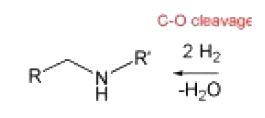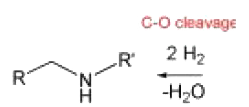Read the passage given below and answer the following questions:
Reduction of carboxylic acids and their derivatives plays an important role in organic synthesis, in both laboratory and industrial processes. Traditionally, the reduction is performed using stochiometric amounts of hydride reagents, generating stochiometric amounts of waste. A much more attractive, atom-economical approach is a catalytic reaction using H2, however, hydrogenation of carboxylic acid derivatives under mild conditions is a very challenging task, with amides presenting the highest challenge among all classes of carbonyl compounds. Very few examples of the important hydrogenation of amides to amines, in which the C-O bond is cleaved with the liberation of water (Scheme 1), were reported. C-O cleavage of amides can also be affected with silanes as reducing agents.

We have now prepared the new, dearomatized, bipyridine-based pincer complex 3, catalyst 3(Here refered as Cat. 3). Remarkably, it efficiently catalyzes the selective hydrogenation of amides to form amines and alcohols (eq 1). The reaction proceeds under mild pressure and neutral conditions, with no additives being required. Since the reaction proceeds well under anhydrous conditions, hydrolytic cleavage of the amide is not involved in this process.

(Balaraman, E., Gnanaprakasam, B., Shimon, L. J., & Milstein, D. (2010). Direct hydrogenation of amides to alcohols and amines under mild conditions. Journal of the American Chemical Society, 132(47), 16756-16758.)
In the following questions, a statement of assertion followed by a statement of reason is given. Choose the correct answer out of the following choices on the basis of the above passage.
Assertion: N-methyl ethanamide on reaction with catalyst 3 will yield ethanol and methanamine.
Reason: Use of Catalyst 3 brings about cleavage of C-N bond of amides
Assertion and reason both are correct statements and reason is correct explanation for assertion.
Assertion and reason both are correct statements but reason is not correct explanation for assertion.
Assertion is correct statement but reason is wrong statement.
Assertion is wrong statement but reason is correct statement.
The correct Answer is:A
Step by step video, text & image solution for Read the passage given below and answer the following questions: Reduction of carboxylic acids and their derivatives plays an important role in organic synthesis, in both laboratory and industrial processes. Traditionally, the reduction is performed using stochiometric amounts of hydride reagents, generating stochiometric amounts of waste. A much more attractive, atom-economical approach is a catalytic reaction using H_2, however, hydrogenation of carboxylic acid derivatives under mild conditions is a very challenging task, with amides presenting the highest challenge among all classes of carbonyl compounds. Very few examples of the important hydrogenation of amides to amines, in which the C-O bond is cleaved with the liberation of water (Scheme 1), were reported. C-O cleavage of amides can also be affected with silanes as reducing agents. We have now prepared the new, dearomatized, bipyridine-based pincer complex 3, catalyst 3(Here refered as Cat. 3). Remarkably, it efficiently catalyzes the selective hydrogenation of amides to form amines and alcohols (eq 1). The reaction proceeds under mild pressure and neutral conditions, with no additives being required. Since the reaction proceeds well under anhydrous conditions, hydrolytic cleavage of the amide is not involved in this process. (Balaraman, E., Gnanaprakasam, B., Shimon, L. J., & Milstein, D. (2010). Direct hydrogenation of amides to alcohols and amines under mild conditions. Journal of the American Chemical Society, 132(47), 16756-16758.) In the following questions, a statement of assertion followed by a statement of reason is given. Choose the correct answer out of the following choices on the basis of the above passage. Assertion: N-methyl ethanamide on reaction with catalyst 3 will yield ethanol and methanamine. Reason: Use of Catalyst 3 brings about cleavage of C-N bond of amides by Chemistry experts to help you in doubts & scoring excellent marks in Class 12 exams.
Topper's Solved these Questions
Similar Questions
Knowledge Check
- Question 1 - Select One
Read the passage given below and answer the following questions:
Reduction of carboxylic acids and their derivatives plays an important role in organic synthesis, in both laboratory and industrial processes. Traditionally, the reduction is performed using stochiometric amounts of hydride reagents, generating stochiometric amounts of waste. A much more attractive, atom-economical approach is a catalytic reaction using H2, however, hydrogenation of carboxylic acid derivatives under mild conditions is a very challenging task, with amides presenting the highest challenge among all classes of carbonyl compounds. Very few examples of the important hydrogenation of amides to amines, in which the C-O bond is cleaved with the liberation of water (Scheme 1), were reported. C-O cleavage of amides can also be affected with silanes as reducing agents.

We have now prepared the new, dearomatized, bipyridine-based pincer complex 3, catalyst 3(Here refered as Cat. 3). Remarkably, it efficiently catalyzes the selective hydrogenation of amides to form amines and alcohols (eq 1). The reaction proceeds under mild pressure and neutral conditions, with no additives being required. Since the reaction proceeds well under anhydrous conditions, hydrolytic cleavage of the amide is not involved in this process.

(Balaraman, E., Gnanaprakasam, B., Shimon, L. J., & Milstein, D. (2010). Direct hydrogenation of amides to alcohols and amines under mild conditions. Journal of the American Chemical Society, 132(47), 16756-16758.)
In the following questions, a statement of assertion followed by a statement of reason is given. Choose the correct answer out of the following choices on the basis of the above passage.
Assertion: The use of catalyst 3 is an efficient method of preparation of primary amines
Reason: Use of catalyst 3 is a step down reaction.AAssertion and reason both are correct statements and reason is correct explanation for assertion.BAssertion and reason both are correct statements but reason is not correct explanation for assertion.CAssertion is correct statement but reason is wrong statement.DAssertion is wrong statement but reason is correct statement. - Question 2 - Select One
Read the passage given below and answer the following questions:
Reduction of carboxylic acids and their derivatives plays an important role in organic synthesis, in both laboratory and industrial processes. Traditionally, the reduction is performed using stochiometric amounts of hydride reagents, generating stochiometric amounts of waste. A much more attractive, atom-economical approach is a catalytic reaction using H2, however, hydrogenation of carboxylic acid derivatives under mild conditions is a very challenging task, with amides presenting the highest challenge among all classes of carbonyl compounds. Very few examples of the important hydrogenation of amides to amines, in which the C-O bond is cleaved with the liberation of water (Scheme 1), were reported. C-O cleavage of amides can also be affected with silanes as reducing agents.

We have now prepared the new, dearomatized, bipyridine-based pincer complex 3, catalyst 3(Here refered as Cat. 3). Remarkably, it efficiently catalyzes the selective hydrogenation of amides to form amines and alcohols (eq 1). The reaction proceeds under mild pressure and neutral conditions, with no additives being required. Since the reaction proceeds well under anhydrous conditions, hydrolytic cleavage of the amide is not involved in this process.

(Balaraman, E., Gnanaprakasam, B., Shimon, L. J., & Milstein, D. (2010). Direct hydrogenation of amides to alcohols and amines under mild conditions. Journal of the American Chemical Society, 132(47), 16756-16758.)
In the following questions, a statement of assertion followed by a statement of reason is given. Choose the correct answer out of the following choices on the basis of the above passage.
Assertion: Aniline can be prepared from suitable amide using catalyst 3
Reason: The use of catalyst 3 is limited to aliphatic amides only.AAssertion and reason both are correct statements and reason is correct explanation for assertion.BAssertion and reason both are correct statements but reason is not correct explanation for assertion.CAssertion is correct statement but reason is wrong statement.DAssertion is wrong statement but reason is correct statement. - Question 3 - Select One
Read the passage given below and answer the following questions:
Reduction of carboxylic acids and their derivatives plays an important role in organic synthesis, in both laboratory and industrial processes. Traditionally, the reduction is performed using stochiometric amounts of hydride reagents, generating stochiometric amounts of waste. A much more attractive, atom-economical approach is a catalytic reaction using H2, however, hydrogenation of carboxylic acid derivatives under mild conditions is a very challenging task, with amides presenting the highest challenge among all classes of carbonyl compounds. Very few examples of the important hydrogenation of amides to amines, in which the C-O bond is cleaved with the liberation of water (Scheme 1), were reported. C-O cleavage of amides can also be affected with silanes as reducing agents.

We have now prepared the new, dearomatized, bipyridine-based pincer complex 3, catalyst 3(Here refered as Cat. 3). Remarkably, it efficiently catalyzes the selective hydrogenation of amides to form amines and alcohols (eq 1). The reaction proceeds under mild pressure and neutral conditions, with no additives being required. Since the reaction proceeds well under anhydrous conditions, hydrolytic cleavage of the amide is not involved in this process.

(Balaraman, E., Gnanaprakasam, B., Shimon, L. J., & Milstein, D. (2010). Direct hydrogenation of amides to alcohols and amines under mild conditions. Journal of the American Chemical Society, 132(47), 16756-16758.)
In the following questions, a statement of assertion followed by a statement of reason is given. Choose the correct answer out of the following choices on the basis of the above passage.
Assertion: Use of hydride catalyst or hydrogen brings about cleavage of C-O bond in amides.
Reason: Hydride catalyst or hydrogen cause to reduction of amides.AAssertion and reason both are correct statements and reason is correct explanation for assertion.BAssertion and reason both are correct statements but reason is not correct explanation for assertion.CAssertion is correct statement but reason is wrong statement.DAssertion is wrong statement but reason is correct statement.
carboxylic acid and their derivatives| preparation| substitution|alkaline hydrolysis of ester
View SolutionReduction of carboxylic acid gives ________.
View SolutionThe general formula of carboxylic acid is :
View SolutionGeneral formula for carboxylic acid is
View SolutionArrange the following derivative of carboxylic acid in their increasing of their acidity.
View Solution
